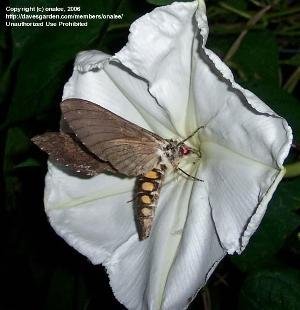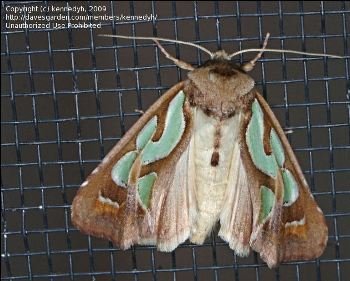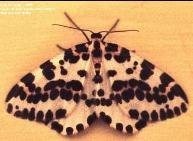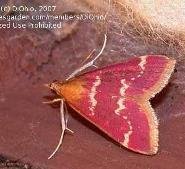





Bees are busy all day, but who works the night shift? Moths. You're familiar with small dull moths that bumble into your porch light, but prettier moths may be closer than you think. Impressive moths can be found in the night garden if you know how to look for them.
opening photo is of a Rothschildia lebeau forbesi - Forbes Rothschild Silkmoth aka Quatro Espejos aka Four Mirrors. Photographer and moth fan Cat Traylor says, "A truly beautiful moth!!! I raise and release them every year. Just had a female lay eggs last week so will be raising another batch this month."
Bees and butterflies get the gold and silver medals for pollination, but who gets the bronze? Moths! Moths are important to the life cycle of a number of plants. In fact, certain plants rely solely on specific moths for natural pollination.

Pollination syndrome? Hint: it's not a new term for seasonal allergies
Pollination is key to flower fertilization and often happens naturally as insects visit flowers for nectar. Many night blooming flowers employ a different strategy for getting themselves fertilized (pollination syndrome) than do the daytime bloomers. While the sun is up, flowers use color to flag down passing insects and birds. In the low light of dusk and night, intense flower colors fade to black. White and pale tones almost glow in moonlight so these are the shades that draw night moths. Odor is another floral attribute important to moths. Strong, sweet or spicy scents draw moths from hundreds of feet away. And when a moth arrives at a scented white flower, it hopes to find a tubular shaped flower that will accommodate its drinking straw shaped mouthpart. All this adds up to a formula used by moth-pollinated plants: tubular flowers in pale colors or white, open late in the day into nighttime, and emitting a strong perfume.
Moth watching adds another dimension to gardening
Moths don't seem to get the attention that bees or butterflies do. But moths are well worth attention. You've likely given them more attention, in their caterpillar phase, than you realize. Moth species far outnumber butterfly species, and includes lots of showy larvae and winged adults. Moth "art" uses graphic design and more subtle color than butterflies' flashy jewel tones. And while moth caterpillars are active (maybe too active) in your garden daily, many mature moths wait until dark to make the rounds.Not just any old moths will do
Moth larvae are incredibly diverse in their feeding habits. Likewise, adult moths vary in their nectaring needs; some don't feed at all. Moths that you'll likely encounter as night pollinators belong to a few groups. Click on the highlighted Latin names below to view a BugFiles listing for the group. Then you can scroll through pages of pictures to whet your appetite for moth viewing.
Noctuidae-
This family is the largest in the butterfly and moth group, with thousands of species in North America alone. Some are called Underwings, named for a colorful second pair of wings that can be hidden under the front wings. Unfortunately for gardeners, the Noctuid family contains some nasty pests like cutworms and corn earworms.
Right: Cosmodes elegans, (Noctuidae), Green-blotched Moth, Victoria Australia
Sphingidae - Sphinx Moths and Hawk Moths
Hawk moths may be the most fun to watch. They are large insects and some are active before dark. You might see one hovering at a flower and mistake it for a hummingbird. You also may have found their huge, fleshy caterpillars chowing down on one of your garden plants or trees. (Tomato lovers dread the tomato hornworm, but those beasts mature into the impressive five-spotted hawk moth shown above at a moonflower.) Hawk and sphinx moths need lots of juice to fuel their fast flight, so they'll especially seek out the biggest nectar-filled blooms.

Geometridae
Measuring worms and inchworms come from the Geometer family, but many adults in this group have fabulous geometric wing patterns.These are small to medium moths with slim bodies.
Left: Common Magpie Moth, (Geometridae), Suffolk, England
Right: Raspberry Pyrausta (Pyralidae)
Pyralidae
Many common small moths belong to this group but they aren't the showiest, as a whole. Unfortunately, quite a few are considered pests.
Maximizing your moths
Some flowers popular with both moths and gardeners
Heliotrope
Jasmine
Butterfly bush (Buddleia)
Spiderflower (Cleome)
Daylily
Red valerian
Gourds (Lagenaria)
Datura
Heather
Nicotianas
Brunfelsia
Four o'clocks
Gardenia
Lantana
Mandevilla
Petunia axillaris
Honeysuckle (Lonicera)
Night scented Stock
Moonflower (Ipomoea alba)
Phlox (Polemoniaceae)
Evening primrose(Oenothera)
Orchids (Angraecum)
Lavender (Lavandula)
Sea daffodil (Pancratium maritimum)
Madonna lily (Lilium candidum)
Yucca
(Above list compiled from sources below and pictures in BugFiles)
Moth hunting
Moths are most active on warm, humid nights. Some start stirring before the sun has fully gone, so keep your eyes open beginning at dusk. If you've planted appropriately, then an evening or nighttime stroll should be a delight for you as well as a good chance to catch moths in action. For more sedentary moth viewing, set up a large white sheet and shine a light on it, or hang a light above it. Wait for the "porch light effect" to bring moths to you. Sugaring is a way to use sweet bait to entice moths to a convenient viewing or photographing location. Sugar baiting for moths will be most successfulon warm, still, humid nights after midsummer.
How to go sugaring for moths: Mix up a thick slurry of brown or white sugar, molasses, ripe or overripe fruit and maybe even a splash of alcoholic beverage of your choice. Allow the mixture to sit in a warm spot for a day or more to ferment, then paint five inch patches on tree trunks, wooden posts or other easy to reach places. It's suggested that you place a trail of baits along a forest edge. Then at dusk, quietly walk the enticing path with a flashlight (and camera) and carefully check for visitors. If you get a clear digital picture of a moth, you can post it on the Dave's Garden Insect and Spider Identification Forum and see if another member can tell you the official name of the critter. If so, you might then be able to add your own picture to Dave's BugFiles. Good luck!
>i< >i< >i<
click here to open Youtube and listen to Beethoven's "Moonlight Sonata"
Credits and Resources
Photograpic credits: Thanks to Dave's Garden members for providing these pictures to BugFiles and permitting this use. TexasPuddyPrint for the Four Mirrors Silkmoth, onalee for the Hawk moth on moonflower, kennedyh for the Common Magpie and Green-Blotched Moths, DiOhio for the Pyrausta
How to start "mothing", - A great publication focused on observing moths
Bugguide.net - All around useful site for browsing images of insects and learning their taxonomy
Bioimages, Vanderbilt University - Description of different pillonation syndromes with beautiful pictures
Perfume for Pollinators, (Brooklyn Botanic Garden) - Article about different flower scents that attract different pollinators
Billo, Pauncho, "Sugaring for Moths," The Catocala Website - A fun article about sugaring
National Biological Information Infrastructure- United States program for accessing information about its natural resources
Borror, Donald J. and Richard E. White, A Field Guide to the Insects of America North of Mexico. Boston, Houghton Mifflin, 1970.
Copyright © www.100flowers.win Botanic Garden All Rights Reserved